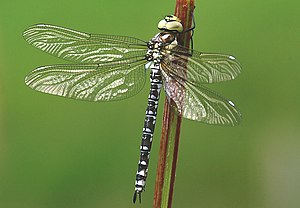Epiprocta
| Epiprocta | ||||||||||||
|---|---|---|---|---|---|---|---|---|---|---|---|---|

Blue-green damsel ( Aeshna cyanea ), female |
||||||||||||
| Systematics | ||||||||||||
|
||||||||||||
| Scientific name | ||||||||||||
| Epiprocta | ||||||||||||
| Lohmann , 1996 |
Epiprocta is a suborder of the dragonflies (Odonata) described in 1996 by the German entomologist Lohmann . This was proposed in order to include the primordial dragonflies (Anisozygoptera) , which are composed of various lines of recent and fossil species and considered paraphyletic , into the phylogenetic system. The remaining recent line of "Anisozygoptera" was okay as part Epiophlebioptera associated with the subordination Epiprocta, as hitherto carried out as a separate suborder dragonfly (Anisoptera), which are also a part of the order Epiprocta in this system. However, there is still no generally recognized system for the lines of the "primeval dragonflies" known only from fossil sources.
features
The subordination is named after an organ on the abdomen of the males, the epiproctum, which is used to grip the females during mating
Partial orders
A line of the former original dragonflies is now summarized in the suborder Epiophlebioptera. Today it only exists with a few species in a single genus. In the Himalayas ( Nepal and Bhutan ) comes Epiophlebia laidlawi before and in Japan superstes Epiophlebia . The geographical gap between the two is closed by the species Epiophlebia sinensis and Epiophlebia diana , which are common in China, but about which little is known.
In the large dragonflies (Anisoptera), the pairs of wings are unequal in size and protrude laterally from the body when at rest. In addition, the dorsal flight muscles are reduced.
Opposite these two groups of Epiprocta are the dragonflies (Zygoptera) as an independent suborder. These do not necessarily have to differ from the Epiprocta in terms of their size, but an essential feature is that they have pairs of wings of the same size, which in most families can be folded back over the body when at rest.
Dragonflies cladogram
| Dragonflies (Odonata) |
|
||||||||||||
|
|
Alternative interpretations
The system proposed by Lohmann reflects the scientific consensus as far as the recent groups of dragonflies are concerned and has been widely accepted and confirmed by numerous recent studies. The proposed nomenclature and designation have not been adopted by all scientists. Many odonatologists name the group instead of Epiprocta Lohmann, 1996 rather Epiproctophora Bechly, 1996. They refer to a paper by Günter Bechly published in the same year . Many others follow a suggestion by Klaas-Douwe Dijkstra and colleagues from 2007 (updated in 2013), who, in order to avoid an unnecessary increase in names from their point of view, have emended the Anisozygoptera (in the rank of subordination) and redefined them so that they only nor include the recent Epiophlebiidae and their immediate relatives. So you avoid a taxon Epiophlebioptera. When using the name Anisozygoptera in the literature, attention should be paid to which taxonomic view the respective processor follows.
The cladogram shown above quickly becomes more complicated and confusing if the numerous fossil finds of dragonflies from the Jura and the Cretaceous are to be taken into account. Different, competing phylogenies exist for these groups to this day, which have to be constantly updated and expanded with further new finds. There are still different opinions about the position of proposed groups such as the Stenophlebioptera and the Heterophlebioptera, and the systematic position of these in relation to the recent groups.
Individual evidence
- ↑ H. Lohmann: The phylogenetic system of the Anisoptera (Odonata). Entomologische Zeitschrift, 106, pp. 209-367, Essen 1996
- ↑ a b Klaas-Douwe B. Dijkstra, et al. (2013): The classification and diversity of dragonflies and damselflies (Odonata). In: Zhang, Z.-Q. (Editor): Animal Biodiversity: An Outline of Higher-level Classification and Survey of Taxonomic Richness (Addenda 2013). Zootaxa 3703 (1): 36-45. doi: 10.11646 / zootaxa.3703.1.9
- ↑ Sebastian Büsse, Benjamin Helmker and Thomas Hörnschemeyer: The thorax morphology of Epiophlebia (Insecta: Odonata) nymphs - including remarks on ontogenesis and evolution. Scientific Reports, 5, 12835, Online August 2015 doi : 10.1038 / srep12835
- ↑ Günter Bechly (1996): Morphological investigations on the wing veins of the recent dragonflies and their main group representatives (Insecta; Pterygota; Odonata), with special consideration of the phylogenetic system and the basic plan of the Odonata. Petalura 2: 1-402. also shown online
literature
- David Grimaldi, Michael S. Engel: Evolution of the Insects. Cambridge University Press, New York 2005, p. 184 ISBN 978-0-521-82149-0
Web links
- Epiprocta, Dragonflies . Museum Victoria Collections, 2010, accessed January 8, 2018